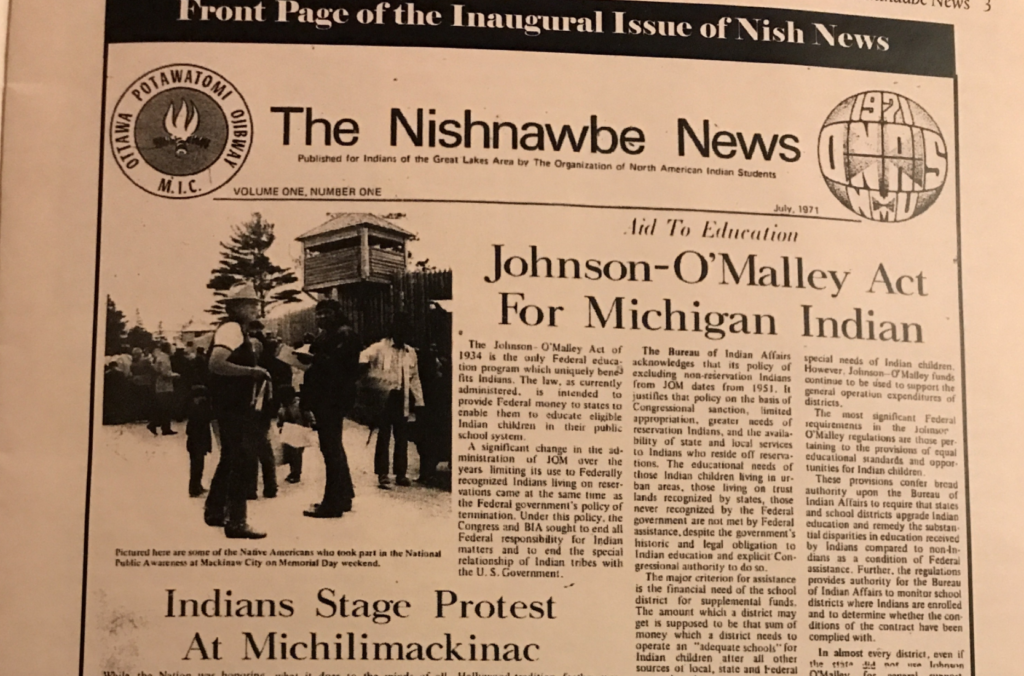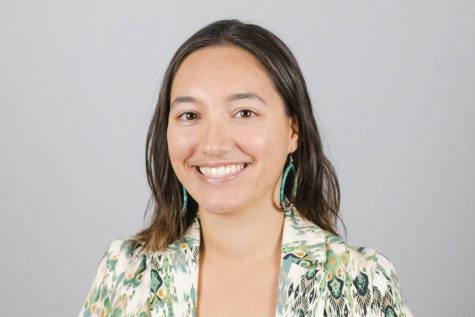In July 1971, the inaugural issue of Anishinaabe News (at the time called Nishnawbe News) was published by The Organization of North American Indian Students. The four-page paper included articles dealing with protests and legal milestones for Native Americans, and it soon became “one of the leading Native-American-run newspapers in the country,” according to the article “The Beginning of Nish News” by Gabe Waskiewicz from Anishinaabe News, Volume 9, Issue 1, October 2013.
According to Waskiewicz, this small newspaper grew into a 12-page broadsheet publication after only four issues and distributed more than 8,000 copies worldwide. “In just two years, Nishnawbe News would grow into the second largest Indian publication in North America, receiving national acclaim in publications like The New York Times and Time Magazine.”
Now, 50 years after its inception, the digital 50th anniversary edition of Anishinaabe News has been released by the Center for Native American Studies. This is not only an anniversary edition of the newspaper; it is also a rebirth.
“This year is a milestone year as it is the 50th year since the newspaper’s inception,” April Lindala, Native American studies professor and former director for CNAS, said. “It hasn’t been in production [or] distribution for [all] fifty years, but I have met or personally know some of the community members from different tribal nations who contributed to the Anishinaabe News from back during the 70s and 80s. It holds a deep source of pride for them.”
Throughout the 50 years of its existence, Anishinaabe News has undergone many hardships and challenges, mainly due to funding. In 1983, the original Nishnawbe News was cut due to decreased funding for higher education. It was revived in 2002 as Anishinaabe News by Martin Reinhardt, the director for the Center for Native American Studies at the time, and was continued by Lindala, his successor.
Anishinaabe News was largely a success and continued to gain readership and recognition. However, in 2016, budget cuts and lack of staffing posed a serious threat to the program.
“The news became rather costly to produce, print, and distribute; the mailing list kept growing and the Center for Native American Studies didn’t have a person who could raise funding for staffing, printing and mailing,” Lindala said. “The biggest blow was when the Center lost the editor position due to budget cuts. At that point, I had to make the very difficult and unpopular decision to put the paper version of Anishinaabe News to bed.”
Even though physical copies of Anishinaabe News were no longer available, Lindala ensured Native news would still be shared through a weekly program called Anishinaabe Radio News on Public Radio 90, WNMU-FM. ARN is very different from the print version of the newspaper in terms of delivery and operation, but Lindala is glad the news and name were able to live on.
Then on Dec. 1, 2020, CNAS hired a new director, Amber Morseau who decided it was time to bring Anishinaabe News back to life for students, staff and community members.
“Anishinaabe News has been a long-standing tradition in our center, a tradition that has seen a few changes since its installment 50 years ago,” Morseau said. “After visiting with our former director, April Lindala, I saw the connection that the Center has with this tradition.”
Instead of focusing on the news-heavy and curriculum-based aspect of the paper, Morseau decided to direct her energy towards the people in the program.
“It was really fun to get to know my faculty through this project. Rather than focusing on course advertisement and saturating the publication with information related to courses, I decided to focus on the people behind this outstanding program,” she said. “With insight ranging from self care to language games, this newsletter is a look into who is teaching our students.”
This latest edition of Anishinaabe News was published in an online newsletter format and shared via email with the NMU community. It can also be found on the NMU website, the CNAS Facebook page and as paper copies in the CNAS. Old editions of the paper can be found in the NMU Archives. Anishinaabe News will be published quarterly based on the seasons.
Bazile Panek, a junior majoring in Native American studies and the president of the Native American Student Association, was the student spotlight for this issue of Anishinaabe News.
“My role in this first issue was writing that initial student spotlight as a Native American studies major … and to show what it is like to be an Indigenous student at Northern Michigan University. I was really excited that Amber reached out to me to write this first piece in the first issue,” Panek said. “I had remembered my freshman year going into the Center for Native American Studies archives room and looking through the old Anishinaabe News newspapers which I thought was really cool. I wanted to see new issues again, so it is really exciting for me to be included in the reinstallment.”
While Panek was one of the students who helped revive the newspaper, he credits Morseau for inspiring and continuing the project.
“I think that new face and new mind under CNAS allowed us to create again and have some new ideas and [Morseau] took the initiative to start Anishinaabe News up again,” Panek said. “It also helps that she is not a faculty member also teaching classes as [former director] April Lindala was.”
One of the reasons Anishinaabe News was able to become a consistent publication once again is Morseau’s ability to make this newsletter a priority. In the past, the absence of student editors has put a lot of pressure on the CNAS director to continue publishing. This was an issue because the director was also a faculty member who had teaching responsibilities outside of their administrative work. Morseau, however, is only the director of CNAS with no other obligations.
“It is my hope that I can continue this tradition more consistently with this advantage, I think I have the coolest job in the world with this paper because I get to hype up our people and learn about them in this fun and interactive way,” Morseau said.
Both Morseau and Panek plan to continue building the newsletter and focusing on individual voices within the Native community.
“Hopefully I can write some more articles that go in the newsletter and I also want to help other Native students to write Native student spotlights. I think that would be a great part to hear from some more Indigenous student voices,” Panek said.
Besides a student spotlight, the newsletter also includes a faculty spotlight on Shirley Brozzo, a seasonal recipe, a language corner, a rez dog weather report and an article on art and self-care.
“I think the most significant part of Anishinaabe News is that it is Indigenous-owned media,” Panek said. “We are taking on an Indigenous-owned media that privileges Indigenous voices. That narrative that was previously written by our oppressors we are now able to create something that we can continue to write our stories with and speak for ourselves for once instead of voices being erased.”






























